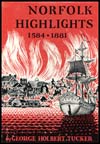Chapter 5
The History of Norfolk's Site
The narrow strip of land fronting the Elizabeth River on which Norfolk was originally established was owned by six early Virginia settlers and one mercantile group before it was laid out as a townsite in 1680-81 by John Ferebee, the surveyor for Lower Norfolk County.
For many years it was believed that the Indian town of Skicoak, one of the three settlements of the Chesepian Indian tribe, supposedly occupied the site of Norfolk. But later historians, after a careful sifting of the evidence, have come to the conclusion that Skicoak was on the Elizabeth River closer to Hampton Roads, while the site that eventually became the nucleus of the present Norfolk was either Indian corn land or primeval forest until the English took over.
In any event, the first white man to own the site on which Norfolk was established was Captain Thomas Willoughby, who patented two hundred acres "upon the first eastern branch of the Elizabeth River" on February 13, 1636/37. *
Born in England around 1601, Willoughby came to Virginia as a boy on the ship Prosperous in 1610. He became one of the most important merchants in Seventeenth Century Virginia, and his "manor plantation" was on the present site of Ocean View. Willoughby was successively a justice of the peace, a member of the Virginia Assembly at Jamestown, and a member of the Governor's Council. He was also a dangerous man to trifle with.
For instance, in 1646, a little over a decade before his death in England in 1658, an indiscreet Lower Norfolk County citizen who slandered him was sentenced by the court to receive fifteen lashes on his bare back, after which he had to appear in all public places for a time wearing a piece of paper bound to his forehead on which a brief account of his peccadillo was inscribed.
Willoughby owned the original site of Norfolk for only seven years, however, for he sold it on April 1, 1644 to John Watkins, another prominent Lower Norfolk County citizen, who again sold it on April 30, 1644, to a man named John Norwood. He continued to hold the property until March 4, 1649/50, at which time he sold the site to Peter Michaelson "and others, owners of the Ship Huis van Nassau (House of Nassau)." This group, headed by Michaelson, is presumed by historians to have been a Dutch trading company.
A few years later, on February 18, 1653/54, the site was bought by Francis Emperor, another merchant, who renewed the patent for the land on March 3, 1656/57, after which it changed hands again, this time to Lewis Vandermuller, presumably another Hollander. On October 19, 1662, the site was bought by Nicholas Wise Sr., who had the deed confirmed on March 18, 1662/63.
It was Wise's son who owned the property in June 1680 when the Virginia Assembly at Jamestown passed an "Act for Co-habitation and the Encouragement of Trade and Manufacture" that provided for the establishment of a town in each of the twenty then-existing Virginia counties.
Once the land was surveyed it was deeded to the trustees of Lower Norfolk County on August 16, 1682, by Nicholas Wise Jr., a shipwright and a son of Nicholas Wise Sr. The fifty-acre tract, purchased from Wise for ten thousand pounds of tobacco in cask, was bounded on the south and west by the Elizabeth River and on the north and east by Back Creek and Dun-in-the-Mire Creek.
As Norfolk was destined to become an important seaport, it was fitting that a seafaring man was the first property owner in the newly established town.
On October 17, 1683, Peter Smith, a mariner, purchased three half-acre lots from the county authorities. These were in the immediate vicinity of what was to become Market Square, later known as Commercial Place. The site is now part of the property owned by the soaring Bank of America.
* Editor's Note: The 1636/1637 notation reflects the difference between the Old Style calendar and the New Style, which England did not adopt until 1752. In the Old Style, New Year's was marked on March 25. So, January 1636 in the Old Style would be what we think of as January 1637.
Chapter 6
The "Half Moone" Fort
Norfolk Highlights 1584 - 1881

See the "Table of Contents" for links to every chapter in Norfolk Highlights 1584 - 1881 by George Holbert Tucker.
